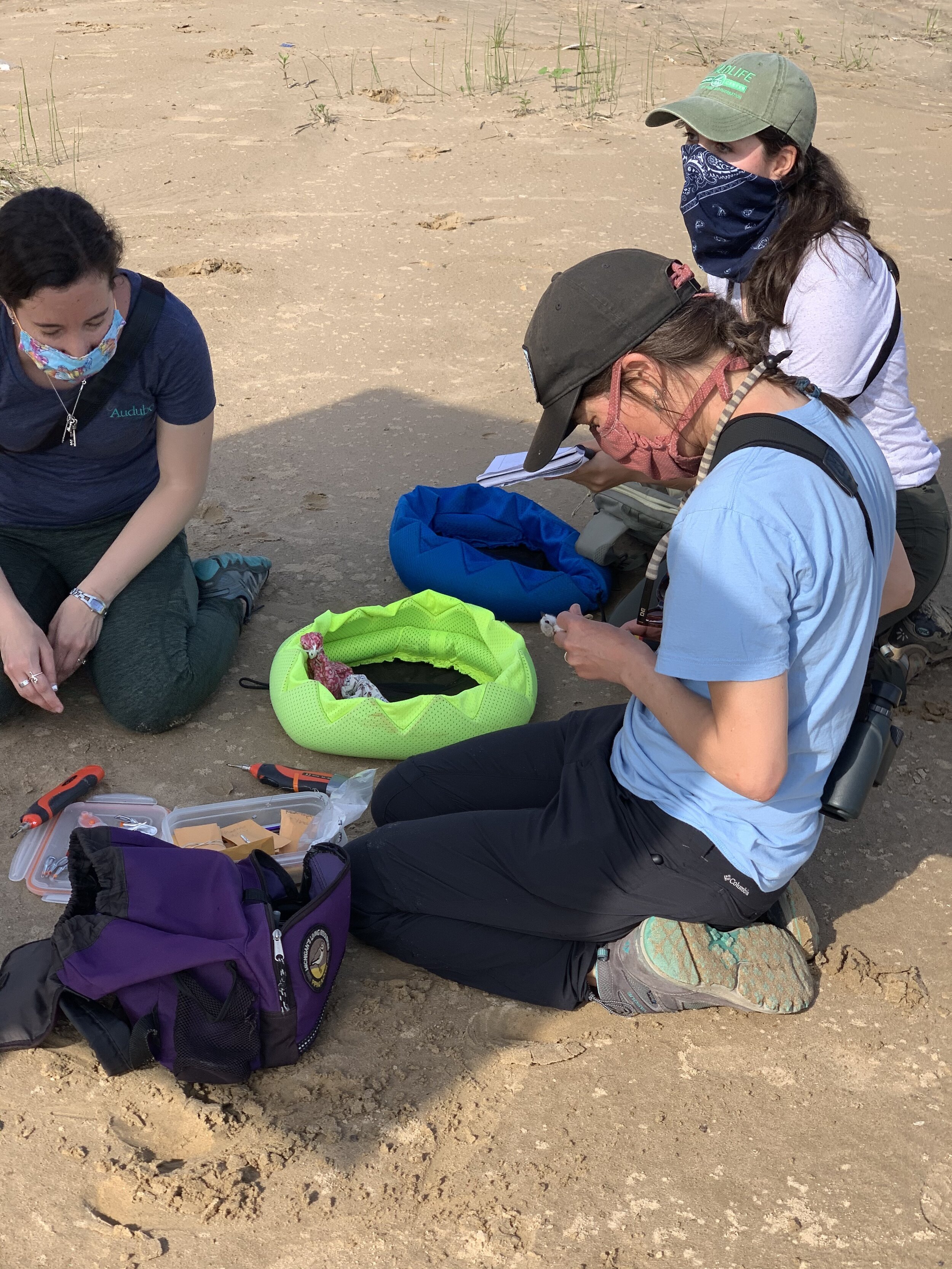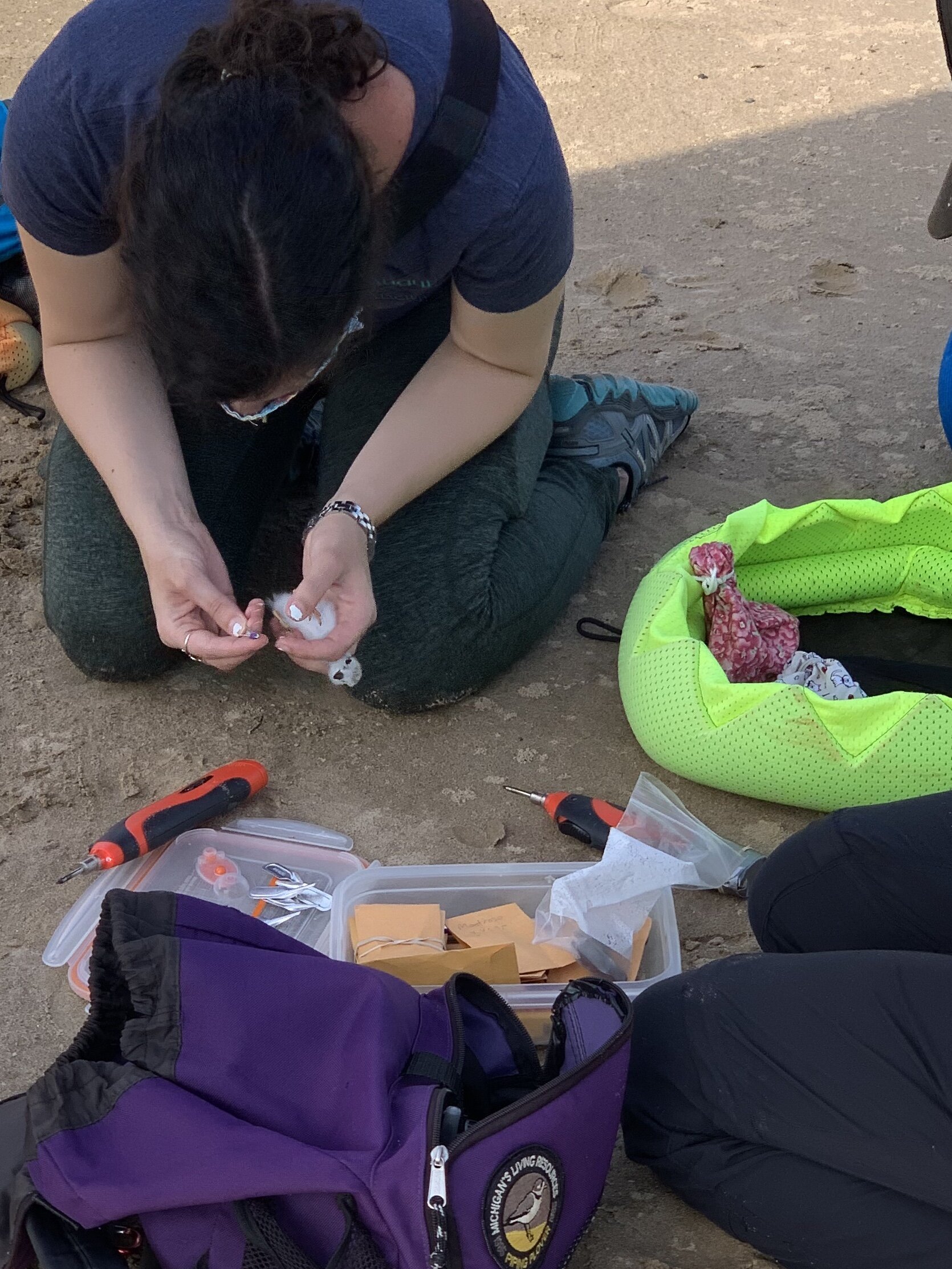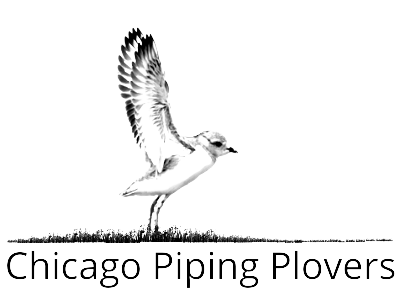The Montrose Piping Plover Chicks Banded 6/29/2020
Today, a team of biologists from the Great Lakes Piping Plover Conservation Team with the assistance of the Chicago Park District, Illinois Department of Natural Resources, Illinois Ornithological Society, National Audubon Society, and the U.S. Fish and Wildlife Service, placed color bands on the three piping plover chicks at Montrose Beach. The color bands will identify the birds as Great Lakes Piping Plovers and as Monty and Rose’s Montrose chicks. Thank you Stephanie Schubel, Sarah Saunders and Hope Caliendo for traveling from Michigan to band our little Piping Plover chicks (featured photo)!
Stephanie Schubel, Sarah Saunders and Hope Caliendo hold the umbrella nets that is dropped over a Piping Plover chick to capture it and band it.
The Bird Banding Laboratory of the U.S. Geological Survey manages a 100 year old program of learning about birds through banding. Each of the banded Great Lakes Piping Plovers receives a USGS aluminum band with a unique 9-digit number. They also get a combination of color-band patterns so they can be recognized by sight or from photos. Every sibling in a family gets the same color and arrangement of three or four bands (depending on the combination used). This is called a "brood marker combination." There aren't enough combinations available to give every chick their own unique identifier from hatching, but by giving the chicks from the same family, or brood, the same combination we can study such things as parental success, fledging rates, and return success. We use specific colors to identify breeding areas so we can usually tell where a chick hatched. The Chicago birds will be identified with a purple band (purple has only been used once before). We put a colored star (red, blue or yellow) on the orange bands so that we can distinguish the chicks while they remain at Montrose. The orange band identifies them as Great Lakes Piping Plovers. Great Lakes Piping Plover chicks are banded between five and fifteen days old. Monty and Rose’s chicks are 11 days old today. The bands are made of either plastic or aluminum, which makes them extremely lightweight. For more information about the Great Lakes Piping Plover Recovery banding program, please visit https://www.greatlakespipingplover.org/banding. Great Lakes Piping Plover recovery work is supported by the U.S. Fish and Wildlife Service with funding through the Great Lakes Restoration Initiative.
The Chicago 2020 Piping Plover chicks are banded as follows:
X,V:O- (Blue Star): Silver band on upper left leg, Purple band on lower left leg, Orange band with Blue Star on upper right leg, no band on lower right leg
X,V:O- (Red Star): Silver band on upper left leg, Purple band on lower left leg, Orange band with Red Star on upper right leg, no band on lower right leg
X,V:O- (Yellow Star): Silver band on upper left leg, Purple band on lower left leg, Orange band with Yellow Star on upper right leg, no band on lower right leg
The Chicago Piping Plover chicks are the only chicks in the Great Lakes to have color stars on their orange bands, in honor of Chicago and Illinois. Typically, Great Lakes chicks have a colored dot on their band.
The endangered Great Lakes Piping Plover population, once down to less than twenty pairs and only in Michigan, has rebounded thanks to recovery efforts. This year so far, we have reports of 65 chicks from nests in Illinois, Michigan, New York, Pennsylvania, Wisconsin, and in Ontario, Canada.Many thanks to everyone who has made this happy event possible! The Chicago Park District has been hard at work during the Lakefront closure ensuring that protections are in place for the plover nesting area, and working with the Illinois Department of Natural Resources, the USDA Wildlife Services, and the U.S. Fish and Wildlife Service in monitoring the safety of the birds. The efforts of the Chicago Park District and the habitat steward who manage the natural area of Montrose Beach Dunes, in conjunction with scores of volunteers, created habitat that supports these endangered birds. Piping Plover monitors coordinated by the Illinois Ornithological Society, the Chicago Audubon Society, and the Chicago Ornithological Society are now onsite helping to protect the plovers and will be available, once the Lakefront reopens, to explain to beachgoers the importance of giving these endangered chicks space to eat and rest. Please respect the safety of the monitors by maintaining a 6-foot distance at all times.
Photos of the banding below are courtesy of Jason Steger, Chicago Park District.






